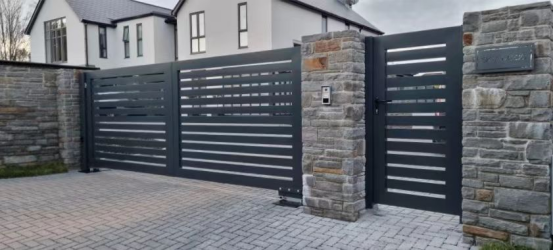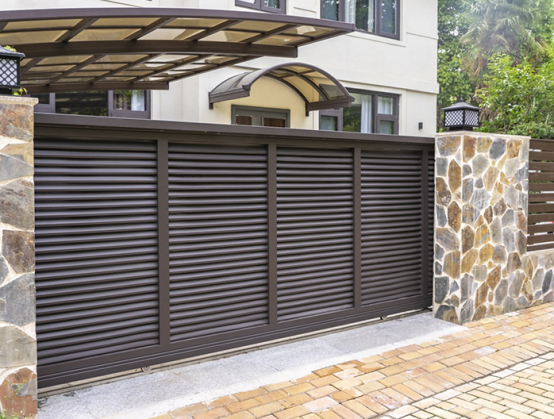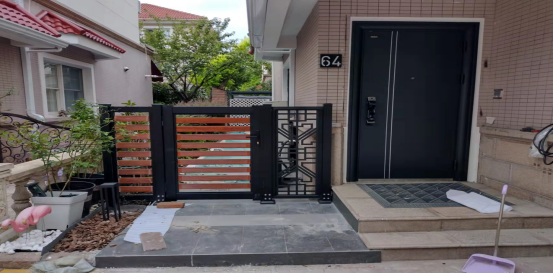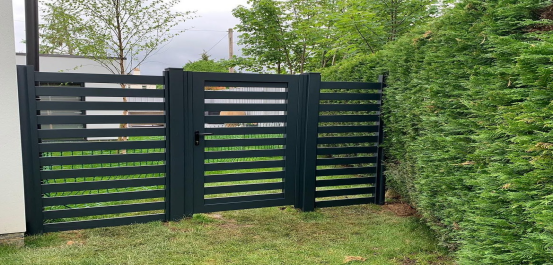

Introduction
The entrance gate serves as both the first line of defense for your property and a statement of your home's architectural character. As we move into 2025, aluminum alloy gates have established themselves as the premium choice for discerning homeowners, offering an unparalleled combination of durability, low maintenance, and design flexibility. This 2000-word guide provides an exhaustive analysis of contemporary gate options, examining structural variations, technological integrations, and material specifications to facilitate an informed purchasing decision.

Section 1: Comparative Analysis of Gate Operating Systems
1.1 Swing Gate Systems
Swing gates, the most traditional option, operate on a simple hinge mechanism that offers several distinct advantages. The complete opening width provides unobstructed access for vehicles up to the full gate width, making them particularly suitable for properties requiring frequent large-item movement. Modern swing gates now incorporate advanced pivot hinge technology that reduces stress on supporting structures while allowing for smoother automated operation.
The primary limitation of swing systems manifests in their spatial requirements. A standard single swing gate demands clearance equal to its width plus approximately 12 inches for operational tolerance. For double swing configurations, this requirement doubles, potentially consuming valuable frontage space. Additionally, ground level variations exceeding 3 degrees may necessitate specialized leveling adjustments during installation to prevent operational issues.
Current market innovations include cantilevered swing systems that eliminate ground contact, reducing friction and maintenance while improving performance in variable weather conditions. These systems typically command a 15-20% price premium over conventional hinged models but offer superior longevity in demanding environments.
1.2 Sliding Gate Mechanisms
Sliding gate systems have evolved significantly from their industrial origins, now offering residential solutions that maximize security while minimizing spatial footprint. Contemporary designs utilize dual-track technology that distributes weight evenly, allowing for smoother operation of gates exceeding 20 feet in width. The concealed track systems now available eliminate the tripping hazards associated with earlier surface-mounted designs.
The mechanical complexity of sliding systems introduces specific maintenance considerations. High-quality models now feature self-cleaning track channels and weather-resistant roller bearings that require only annual lubrication. However, properties in areas with significant leaf fall or blowing debris may require more frequent track inspections to maintain optimal performance.
Recent advancements include magnetic levitation sliding systems that eliminate physical track contact entirely. While currently representing only about 5% of the residential market due to their substantial cost premium, these systems demonstrate the direction of future development in gate technology.

1.3 Folding Gate Configurations
Folding or bi-fold gate systems represent the most space-efficient solution, with modern telescoping designs able to reduce their footprint by up to 70% when opened. The current generation of folding mechanisms incorporates multi-point locking systems that provide security equivalent to traditional solid-panel gates while maintaining their space-saving advantages.
The increased mechanical complexity of folding systems necessitates more rigorous maintenance protocols. High-end models now feature sealed bearing assemblies and stainless steel hinge mechanisms that extend service intervals to approximately 18 months. However, the additional moving components still result in a 25-30% higher maintenance cost compared to simpler gate types over a 10-year period.
Design innovations in this category include cantilevered folding systems that eliminate ground guides entirely, and modular panel designs that allow for customized width configurations. These developments have significantly expanded the architectural applications of folding gate systems in high-end residential projects.
Section 2: Smart Technology Integration
2.1 Access Control Systems
Modern gate access systems have evolved beyond simple remote controls to incorporate multi-factor authentication protocols. Current biometric systems now combine fingerprint recognition with palm vein scanning technology, achieving false acceptance rates below 0.0001%. These systems integrate with home automation platforms through standardized protocols like Z-Wave and Matter, allowing for seamless incorporation into existing smart home ecosystems.
The latest generation of license plate recognition systems utilizes machine learning algorithms that maintain 99.2% accuracy in various lighting and weather conditions. When paired with vehicle detection loops embedded in driveways, these systems can automatically open gates for recognized vehicles while maintaining security against unauthorized access.
2.2 Automation and Control Systems
Gate automation technology has seen significant improvements in energy efficiency and reliability. The current market-leading motors now operate on 24V DC systems with power consumption reduced by 40% compared to previous generation AC motors. Solar charging systems have become increasingly viable, with high-efficiency panels now capable of providing complete operational independence in most climates.
Advanced control systems now incorporate predictive opening algorithms that analyze historical access patterns to anticipate gate operation needs. These systems can reduce unnecessary motor activations by up to 30%, significantly extending component lifespan. Integration with weather monitoring systems allows for automatic adjustment of operational parameters based on current conditions, such as reducing opening speed during high winds.
2.3 Security and Monitoring Solutions
Modern gate security systems now combine multiple detection modalities for comprehensive protection. Millimeter-wave radar sensors provide reliable presence detection unaffected by visual obstructions like fog or heavy rain, while thermal imaging cameras can distinguish between humans, animals, and vehicles with 98% accuracy.
The latest surveillance systems employ edge computing technology to process video feeds locally, reducing bandwidth requirements while enabling real-time threat analysis. These systems can detect suspicious behaviors like loitering or repeated access attempts and trigger appropriate security responses without requiring cloud processing.
Section 3: Material Science and Engineering
3.1 Aluminum Alloy Composition
Contemporary gate-grade aluminum alloys typically use 6000-series formulations, with 6061-T6 being the current industry standard for structural components. These alloys provide tensile strengths exceeding 290 MPa while maintaining excellent corrosion resistance. Recent developments in nano-ceramic coatings have further enhanced surface hardness, with some treatments achieving 9H pencil hardness ratings while maintaining flexibility to prevent cracking.
The latest powder coating technologies now offer 40% improved UV resistance compared to earlier formulations, with color retention warranties extending to 25 years in some premium products. Advanced application techniques allow for variable thickness coatings that provide additional protection in high-wear areas while maintaining aesthetic consistency across the entire gate surface.
3.2 Structural Engineering Considerations
Modern aluminum gate frames now incorporate finite element analysis-optimized designs that minimize material usage while maintaining structural integrity. Hollow extruded sections with internal reinforcement webs provide stiffness comparable to solid steel components at 60% reduced weight. These designs also incorporate thermal breaks that improve performance in extreme temperature variations.
The latest connection systems utilize friction-stir welding techniques that create joints with 95% of base material strength, eliminating the weak points associated with traditional mechanical fasteners. These advanced joining methods have enabled the development of seamless gate designs that combine superior aesthetics with enhanced durability.
3.3 Environmental Performance
The environmental advantages of aluminum gates have been further enhanced by recent manufacturing innovations. Current production methods now achieve 75% recycled content in primary extrusions, with some manufacturers offering closed-loop recycling programs for end-of-life products. The embodied energy of premium aluminum gate systems has been reduced by 35% over the past decade through process optimization and renewable energy adoption in production facilities.

Section 4: Selection and Implementation Guidelines
4.1 Site Assessment Protocol
A comprehensive site evaluation should include:
- Detailed topographic survey with 1cm accuracy
- Soil composition analysis for foundation planning
- Microclimate assessment including wind patterns and precipitation data
- Existing infrastructure mapping for utility conflicts
4.2 Performance Specification Development
Key parameters to define:
- Required operational cycles per day
- Emergency access requirements
- Noise level limitations
- Security threat profile assessment
- Expected maintenance accessibility
4.3 Installation Best Practices
Current industry standards recommend:
- Laser-aligned mounting systems for precision installation
- Vibration-dampened motor mounting
- Isolated power supply with surge protection
- Dedicated data conduit for smart systems
- Environmental sealing of all electrical components
4.4 Maintenance Planning
A comprehensive maintenance program should include:
- Semi-annual mechanical system inspections
- Annual coating integrity checks
- Biannual software updates for smart systems
- 5-year structural integrity assessment
- Predictive replacement scheduling for wear components

Conclusion
The 2025 aluminum gate market offers solutions that combine advanced materials science with cutting-edge technology to create entrance systems that are simultaneously more secure, more durable, and more intelligent than ever before. By carefully considering the operational requirements, technological integrations, and material specifications outlined in this guide, property owners can select gate systems that will provide reliable performance and aesthetic appeal for decades to come. The ongoing evolution of gate technology promises even more sophisticated solutions in the coming years, with developments in materials, automation, and security systems continuing to redefine the possibilities for residential entrance solutions.
Email format error
Email cannot be empty
Email already exists
6-20 characters(letters plus numbers only)
The password is inconsistent
Email format error
Email cannot be empty
Email does not exist
6-20 characters(letters plus numbers only)
The password is inconsistent